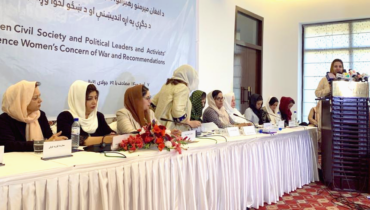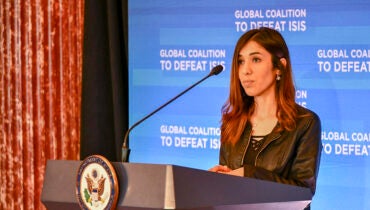There is a preponderance of theory and anecdote in countering violent extremism (CVE) work to date. What is chronically missing are empirical studies and good qualitative and quantitative evidence to bolster—or challenge—the common assumptions about CVE practice and policy. Compounding this issue is an almost complete lack of quantitative studies on women’s roles in violent extremism (VE), CVE, and the push/pull factors of radicalization.
A great deal of the current theory in CVE work derives from lessons learned in development, conflict, and social psychology research. These theories include the application of formalized psychological theories, such as Social Movement or Resource Mobilization. They also include the expansion of development and gender-focused field frameworks, such as the idea that because women reinvest more of their earnings into their communities, which from a development perspective is beneficial, it must also be more worth-while to invest in women in CVE programming. Other ideas stem from the peace and conflict literature, like community policing or the comparisons of radicalization to gang recruitment and violence. Additionally, the field of VE study has generated some of its own unique theories, such as the potential roles of women’s civil society organizations in CVE. All of these theories and proposals, however, lack significant hard data to support—or refute—their validity. They are being implemented in the field and in policy with the blessings of the academic community and practitioners alike, but without the cold rigor required of other fields—medicine, for instance—even though they too deal with potential life-or-death consequences.
This discussion arises out of a desire to bolster the work already being done with additional evidence; it is not directed as a critique or outright dismissal of any of the existing views on CVE. The goal of evidence is to see where we have set a good course, where we have not, and how we can alter that course to improve results. There are some strong case study analyses, interviews, and other qualitative studies concerning CVE in general, and even some focusing on women in VE/CVE/radical ideologies. The theories discussed above (and others too) have their place in CVE research, policy, and practice. Issues occur, however, when theory is posited based solely upon perceived connections from mere observations and anecdotal evidence, no matter how logical these connections may seem. Theory should arise from systematic observation, inquiry, and testing; it should not be derived from anecdote and assumption.
CVE research and discussion has raised many questions—and continues to raise more—as new views are added and new lessons learned. As the field continues to move forward, the following questions must be asked, and ultimately answered, more explicitly—and with care taken to minimize potential risks to researchers and subjects.
Are women truly more likely to exercise CVE effects if empowered economically, politically, and socially? There are myriad development and CVE-specific programs already in place doing impressive work on women’s empowerment, education, and in various CVE efforts as well as VE activities. Let’s leverage these programs by funding adequate monitoring and evaluation studies. These studies can and should include interviews and other examinations of how these programs have (or have not) changed how women relate to their social networks and elicit any potential interactions with extremist ideologies or persons showing signs of radicalization.
To what degree do women pass on peacebuilding abilities and to whom? Many researchers claim women are more likely to pass along peacebuilding skills and promote alternative solutions to violence. If so, to what degree do they surpass men in this area (probably significantly in many cases, but that cannot be said for certain without adequate data). This point brings up a second issue: if women are already better suited to spreading peacebuilding practice, should efforts not focus on the other gender? Does programming need to focus on how to make men more receptive to women’s peacebuilding efforts in the first place? Or is it enough to empower women in this role and let the men sit as a constant, not a variable, in this equation?
Finally, if radicalization is a multifaceted process (a conclusion which does have significant supporting evidence, both quantitative and qualitative), at which facets are women most successful at intervening and derailing the radicalization process? This research will likely require a longitudinal study and significant patience. It will need to look across a range of programs and CVE efforts in multiple countries and regions. Comparative data will be difficult to gather. As there is no such thing as “proving a negative,” the problem of how to show that people are notturning to violent extremism due to CVE efforts becomes a difficult one to solve. There is a potential solution, however:
Thus far CVE studies have strongly focused on identifying the push/pull factors of radicalization. This approach seems obvious: find out what makes people radicalize to the point of violence, then attempt to interdict these factors at various points along the timeframe of radicalization. This approach of trying to inhibit every factor of radicalization, or to detect radicalization as it is occurring, has thus far proven only partially successful at best in relatively stable environments. Perhaps a new approach is needed.
In attempting to tamp down the push factors of VE, the field may have stumbled across a novel approach to CVE: look at what has prevented the vast majority of potential actors from radicalizing to violence. So far, most attention has been on looking at what caused radicalization and then trying to stop those processes through targeted programs. Recently, more and more of these programs are addressing gender and other complexities as factors contributing to the push-pulls of extremism. But what if we take the other perspective? Perhaps it would be more beneficial to conduct interviews with those that have notradicalized and simply ask “Why not?” Why have so many not turned to violence or radical ideologies when some of their compatriots have? What keeps more people from flocking to ISIS or Boko Haram? From the gender perspective, we need to be assessing what networks factor into a person’s response to these questions. Are women and men, boys and girls prevented from radicalizing by different networks, associations, or influences? Asking women and men what ties keep them from joining radical groups or committing violent acts could shed new, much needed light on how each gender affects the other in preventing radicalization. It could also reveal how well current programs are working (if they are working) and where they need support or reevaluation.
This new avenue of research could provide many answers and much needed evidence to support existing theories or develop new, more solid conceptualizations of radicalization and non-radicalization processes. To understand the why we must first understand the why not.
The fields of CVE study and, especially, women’s roles in CVE are new, critical to national and international security, and should be treated as such. These areas deserve due attention. Researchers, practitioners, and policy-makers alike have the opportunity to create strong bodies of evidence-based knowledge, theory, and guidelines. For too long women have been under-acknowledged in development, peacebuilding, and conflict. Due to international actions like UNSCR 1325 and 2242 and the tireless work of advocates in the field and in policy and academia, CVE research has managed to incorporate women into the paradigm relatively early compared to many other areas of practice. But these efforts will mean so much more if present gaps in knowledge are addressed. It is critical to avoid rushing to make conclusions and decisions based upon assumption and anecdote if this field of study is to be truly effective and set an example for future work on women’s issues, conflict, and peace.
About the Author
Alex Rohlwing is a graduate research assistant with the Institute, entering his second year in Georgetown’s Conflict Resolution program. Alex has a BA in Cultural Anthropology with a minor in History from the University of Florida. After working in the emergency medical sector as an EMT and Paramedic for several years, Alex turned his attention to disaster and conflict response and recovery. His studies at Georgetown focus on conflicts in emergency and disaster contexts and integrating conflict resilience into disaster recovery.


